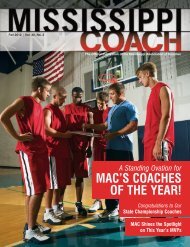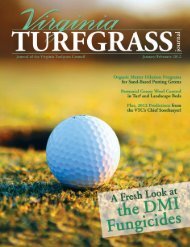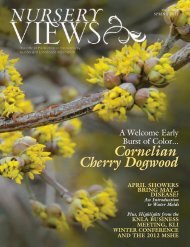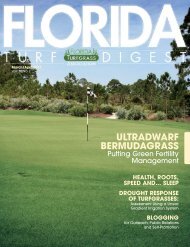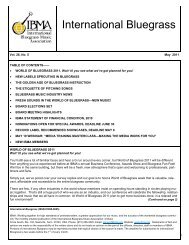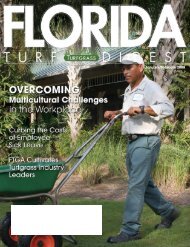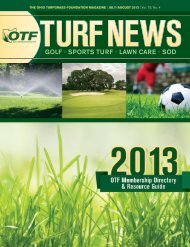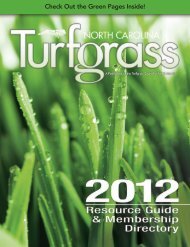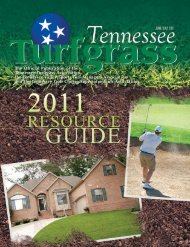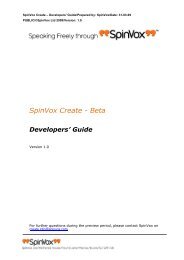Annual Meeting of Maryland Turfgrass Council
Annual Meeting of Maryland Turfgrass Council
Annual Meeting of Maryland Turfgrass Council
- No tags were found...
Create successful ePaper yourself
Turn your PDF publications into a flip-book with our unique Google optimized e-Paper software.
<strong>Annual</strong> <strong>Meeting</strong> <strong>of</strong> <strong>Maryland</strong> <strong>Turfgrass</strong> <strong>Council</strong>Wednesday, January 23 rd , 2002U.M. Paint Branch Facility395 Greenmeade Drive College Park, MD 20742-372112:00 noon – until business is completedThis year, the <strong>Annual</strong> <strong>Meeting</strong> <strong>of</strong> the <strong>Maryland</strong> <strong>Turfgrass</strong> <strong>Council</strong> will be convened at the University <strong>of</strong><strong>Maryland</strong> Paint Branch <strong>Turfgrass</strong> Research Facility. The order <strong>of</strong> business at this meeting shall be:1. Roll call <strong>of</strong> members: To establish the presence and number <strong>of</strong> members eligible to vote.2. Pro<strong>of</strong> <strong>of</strong> notice: To verify that appropriate notice was given prior to the annual meeting.3. Report <strong>of</strong> the President: To summarize the events <strong>of</strong> the past year and plans for to the next.4. Reports <strong>of</strong> other Officers: To summarize their activities, accomplishments, etc.5. Presentation <strong>of</strong> the annual audit: To provide a verbal report with summary written account.6. Unfinished business: To discuss matters unresolved or in progress since the last meeting.7. New business: To discuss issues brought to the floor by <strong>of</strong>ficers, Board, or membership.8. Election <strong>of</strong> Officers and Board <strong>of</strong> Directors: To nominate and elect these positions.On the agenda <strong>of</strong> new business will be a discussion <strong>of</strong> the new MTC website (mdturfcouncil.org) anddiscussion/ratification <strong>of</strong> MTC Constitution and Bylaws, tentatively approved by the Board <strong>of</strong> Directors onAugust 17, 2001. If you would like to receive a copy <strong>of</strong> the approved Constitution & Bylaws, or needadditional information or directions to the <strong>Annual</strong> <strong>Meeting</strong>, please contact John Krouse at 301-345-4199.
Gary LucksNominated to Serve on Board <strong>of</strong> DirectorsThe <strong>Maryland</strong> <strong>Turfgrass</strong> <strong>Council</strong> is pleased to announce that Gary Lucks <strong>of</strong> Lucks Sales Associates in Salisburyhas been nominated to serve on the Board <strong>of</strong> Directors as a representative <strong>of</strong> sod producers and the sod industry.Gary has been involved in sod production and sales for over 13 years, working with all types <strong>of</strong> cool and warmseason grasses. Prior to his involvement with sod, Gary was employed as a golf course superintendent atGarrisons Lake G.C. (Smyrna, DE), Sleepy Hole G.C. (Suffolk, VA), and Sea Scape G.C. (Kitty Hawk, NC). Itwas during his employment in North Carolina that Gary became interested in sod production, which led to aposition with United Turf. He became President <strong>of</strong> United Turf in 1989. This past September, Gary started hisown company, Lucks Sales Associates, that represents eight sod farms from North Carolina to New Jersey.
MTC Scholarship Recipients SelectedThis year, the <strong>Maryland</strong> <strong>Turfgrass</strong> <strong>Council</strong> has selected three recipients for its scholarshipprogram, all <strong>of</strong> whom were enthusiastically recommended by their employers. The threestudents will each receive $1000 towards their tuition at the University <strong>of</strong> <strong>Maryland</strong>, aswell as a certificate at <strong>Turfgrass</strong> 2002 on Wednesday, Jan. 30 th .Daniel De Giovine George Waranowitz Richard MarantoDaniel De Giovine is employed at Chevy Chase Club, in Chevy Chase, and GeorgeWaranowitz is employed at Mellomar Golf Park in Owings, Md. Both Daniel andGeorge are seniors in the Turf & Golf Course Management Program <strong>of</strong> the Dept. <strong>of</strong>Natural Resource Sciences & Landscape Architecture at The University <strong>of</strong> <strong>Maryland</strong> inCollege Park. Richard Maranto, Jr. is employed at South River Golf Links in Edgewater,Md. and is enrolled in the <strong>Turfgrass</strong> Management Program <strong>of</strong> The Univ. <strong>of</strong> Md. Institute<strong>of</strong> Applied Agriculture.
PRESIDENT'S MESSAGE WINTER 01The <strong>Maryland</strong> <strong>Turfgrass</strong> <strong>Council</strong> is busy putting the final touches on our 25th <strong>Annual</strong>Conference and Trade Show. One <strong>of</strong> the presentations at this important event willhonor the former Presidents <strong>of</strong> MTC for their assistance and dedication to the <strong>Council</strong>.Occasionally, before an organization can move forward and prosper in a new direction itis important to take a look back to see where it has been. By understanding the trialsand tribulations <strong>of</strong> the people who preceded us, we can <strong>of</strong>ten gain a new perspective andinsight on ways to ensure future success. After reviewing the history <strong>of</strong> MTC, thissmall tribute for our past presidents barely seems sufficient.On November 20 th , 1972, thirty-six people involved in the <strong>Maryland</strong> turfgrass industrymet to establish an organization that would unite the interests <strong>of</strong> individuals, privateindustry, organizations, and public and private institutions in order to promote thescience, technology and improvement <strong>of</strong> turfgrass and turfgrass education in the State <strong>of</strong><strong>Maryland</strong> without regard to race, creed, color, sex, or national origin. Their vision was20/20, because those are the same objectives that we have today.Everyone knew a strong foundation would be required if MTC were to endure. FormerPresidents Angelo Cammarota, Dick M<strong>of</strong>fett, John Strickland, Bob Larsen, and EmoryPatton, along with advisor Jack Hall from the University <strong>of</strong> <strong>Maryland</strong> had the fortitudeto prepare the foundation that MTC would need to be successful. They not only pavedthe way for effectively dealing with many issues that affect our industry, they illustratedthe importance <strong>of</strong> turfgrass to the State’s economy and made sure our industry receivedthe recognition it deserved.As a result, they received legislative support for concerns about pesticide use andfunding for the U.M. Turf Research Facility, and developed a vehicle for educating theindustry... our <strong>Annual</strong> Conference and Trade Show. Their actions benefited us then,and continue to benefit us today. Of course it was not all glory. There were manypersonal and pr<strong>of</strong>essional sacrifices by former Presidents, <strong>of</strong>ficers, and board members<strong>of</strong> MTC. I think that it's most fitting, especially during our 25th <strong>Annual</strong> Conference, togive thanks for their dedication, which has resulted in so many accomplishments.Our annual golf tournament was the most successful to date. It was a beautiful day on amagnificent golf course at Woodmont C.C. Our thanks go out to everyone whoparticipated in this event, and especially to Mike Larsen and his staff for providingMTC with a wonderful facility and making everyone feel at home. All proceeds godirectly to <strong>Turfgrass</strong> Research at the University <strong>of</strong> <strong>Maryland</strong>. I would also like toexpress my gratitude to Lance Ernst for organizing this event, along with Kathie
Torrance, John Krouse and Steve Evans for providing support and helping to ensure thatthis event will continue to be successful in the future.We are excited that our new website at mdturfcouncil.org will be a reality in January.John Krouse. Kevin Mathias, Rick LaNore, and Becky Sunday were instrumental indesigning and implementing this project, and have done an outstanding job. Thiswebsite will definitely be an asset to the <strong>Council</strong> and to the members <strong>of</strong> the turfgrassassociations that we represent.I would like to extend to everyone and their families a safe and joyous holiday seasonand I look forward to seeing each <strong>of</strong> you at <strong>Turfgrass</strong> 2002.
Random Notesby Dave CammarotaA Season <strong>of</strong> ReflectionsIt’s hard to believe that we are ending our first year<strong>of</strong> the New Millennium. I began the year by notingthe abnormal weather, and since then not much haschanged. We've all had a dry but beautiful IndianSummer.Unfortunately, our political ‘weather’ has given us avery different sort <strong>of</strong> season. And despite the factthat nearly every one else has already commentedon the events <strong>of</strong> September 11 th , I find it difficult toavoid expressing my own sentiments. So heregoes...These events have given all <strong>of</strong> us reason to reflecton the sanctity <strong>of</strong> our lives and <strong>of</strong> those whom wehold most dear. The one bright spot in this rottenaffair is that, in spite <strong>of</strong> the havoc it's caused, ournation has felt a unity that hasn’t been seen for over50 years.The response from American citizens has beenamazing. Just as we saw at the onset <strong>of</strong> World WarII, our kids are joining the armed forces in recordnumbers. We have rallied around our President inan effort to search and destroy those who havesought to destroy us.Leave it to Americans to rally around a negativeand respond with a positive. I'm reminded <strong>of</strong> aspeech given by my father to a session <strong>of</strong> golfcourse superintendents, where his topic was‘Accentuate the positive, eliminate the negative.’And I recall an example when I was a younger manat Sparrows Point Country Club...One morning, I was making my rounds, preparingfor a ladies tournament, when I discovered thatvandals had a drinking party on one <strong>of</strong> our greens.There was an empty whiskey bottle buried up to itsneck right in the middle, and obscenities werescratched into the turf with a bunker rake. Shards<strong>of</strong> turf were everywhere. In those days, bunkerrakes had magnesium alloy teeth (now we knowwhy they are made <strong>of</strong> rubberized plastic!).So I hurried back to the shop to get repair materials,and went back to fix the green. After I had replacedall the turf, I got down on my hands and knees tobegin the task <strong>of</strong> rubbing topdressing into thescratched words.It was about then that Mrs. Potts appeared, a kindold lady who played almost daily. She came upbehind me as I kneeled over the last obscenity to berepaired, and in a surprised tone asked "Dave,what's happened here?"I causually looked up and explained that we hadsome vandals overnight. In a moment, her gentleface was knotted in anger. She put her hands on herhips and said, "What’s wrong with people thesedays? How can they be so disrespectful, sodeliquent, so juvenile, so...so...so...” I could see shewas searching for yet another adjective, so I said"So illiterate?”She looked down at me, blankly. So I continued"Well sure; this clown couldn't even spell shirt."And in an instant, as quickly as it had come, theanger was gone. Mrs. Potts marched <strong>of</strong>f the greenchuckling at my stupid remark. For her it was anoutrage; for me, it was just another day at the golfcourse. Accentuate the positive.Since September 11 th , I have noticed a hugeincrease in common courtesy, especially on theroad. Drivers seem more tolerant. No one hasflipped me "the bird" in 3 months. The spirit <strong>of</strong> theseason <strong>of</strong> September 11 th is certainly contagious. Ihope it continues for a long time.Best wishes for a happier and more peaceful newyear.Don’t let the ‘shirt-heads’ get you down.Dave
Tips for Turf ExpertsWinter & SpringEditor’s note: Tips for Turf Experts is the 4th column in the series to appear in MTC News. These little bits <strong>of</strong> fact andwisdom are intended for turf managers in the <strong>Maryland</strong> area, but may not be true outside our region.What’s Cation Exchange Capacity? Can I increase it?Answer: Cation exchange capacity or CEC is the ability <strong>of</strong>soils to store nutrients like potassium, calcium, andmagnesium. Soils high in clay and organic matter usuallyhave a high CEC, while sandy soils have a low CEC.Because <strong>of</strong> this, it is difficult to increase CEC very much.However, by returning grass clippings, using organicfetilizer high in humus, and liming to maintaining pHbetween 5.5 and 6.5, you will maximize the potential CEC<strong>of</strong> your soil, and slowly improve it. Winter is a good timeto start the process!What is Anion Exchange Capacity?Answer: Although seldom discussed, all soils have anionAND cation exchange capacity. Anions in soil includephosphorus, nitrogen, and sulfate. Anion exchangecapacity is usually more difficult to improve than cationexchange capacity, because neither clay, silt, or sandparticles store anions very well. Sandy soils areespecially prone to lose their nitrogen, sulfur, andphosphorus. Organic matter is much more important inanion exchange, so boosting the organic matter (whilemaintaining pH between 5.5 and 6.5) is your best strategyto increase the ability <strong>of</strong> soil to hold these nutrients.What is the best de-icer to use on sidewalks anddriveways near turfgrass?Answer: As much as possible, try to avoid the turf and usethe minimum necessary. Sodium chloride (rock salt) andcalcium chloride are best for most purposes... but they aretoxic and a little usually goes a long way. Never use ureaor fertilizers for de-icing! They are <strong>of</strong>ten less effectiveand very harmful to waterways, including the bay. Anddon’t forget the sand! Sand is inexpensive, non-toxic,improves traction, helps to melt ice on sunny days, andshould be used whenever ice is not expected to last.What happens to de-icers that are applied to turf, orthat run <strong>of</strong>f from sidewalks, etc. into grassy areas?Answer: Eventually, they will be ‘washed’ out <strong>of</strong> the soilby rain or irrigation, but the rate depends on the cationand anion exchange capacities <strong>of</strong> the soil. Ironically,soils with poor exchange capacity will shed excesssodium, chlorine, and other salty ions quicker than soilswith high exchange capacities, but the effect <strong>of</strong> the saltyde-icers will generally be more severe in the short run.Because such soils can’t store these chemicals in a formthat is ‘safe’ for plants, their concentrations in the soilsolution can get so high, and so quickly, that plants die.Soils with high exchange capacities will store these ionslonger, and as long as the concentrations are low, there islittle problem. But when high exchange capacity soilshave high concentrations <strong>of</strong> toxic ions, it may take yearsbefore rain ‘washes’ the ions out <strong>of</strong> the soil.Does traffic in winter cause turf damage?Answer: Winter traffic can damage turf in many ways.Because soils are <strong>of</strong>ten wet in winter they are prone tocompaction, and heavy traffic can destroy soil structureleading to drainage problems. Although it may take awhile to appear, traffic on frosted turf can kill leaves andcrowns, and leave dead footprints or wheel-stripes.Shearing occurs when traffic such as golf carts or footballplayers pull s<strong>of</strong>t, thawed sod away from the frozen soilbeneath it. Often the damage is invisible until the grassturns brown. Try to stay <strong>of</strong>f wet, frozen or thawing turf.When is the earliest that I can seed cool season turf?Answer: It depends on the weather in any given year. Ina warm spring you may be able to seed in late February,and have some germination by mid-March, but usuallythat’s pushing it. Perennial ryegrass will <strong>of</strong>ten germinateand grow when tall fescue, fine fescues, and Kentuckybluegrass will not. Tall fescue and fine fescue are theriskiest- they usually germinate and grow poorly in theearly spring. If you must seed when soil temperatures areless than 50 degrees, consider Kentucky bluegrass andperennial ryegrass. The rye will <strong>of</strong>ten germinate andgrow during warm spells, and the bluegrass will follow.Are some fertilizers better than others for enhancingwinter color and growth?Answer: It always depends on the results <strong>of</strong> a recent soiltest, but there is some data to support the use <strong>of</strong> highpotassium fertilizers to improve the winter and earlyspring color <strong>of</strong> cool season turf. Higher potassium levelsseem to reduce winter discoloration and damage fromdesiccation. Use potassium sulfate whenever possible(sulfate is an important nutrient, and also enhances turfcolor). Although potassium is rarely an important aspect<strong>of</strong> most turf fertilization programs (which tend to focus onnitrogen fertility), potassium is an important plantnutrient, and is lost whenever clippings are removed. Ingeneral, potassium levels are usually lowest in sandysoils, but are rarely low in clay soils.




